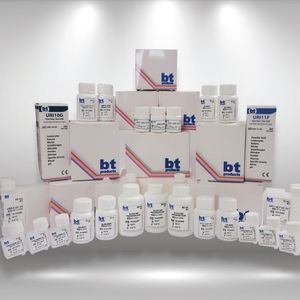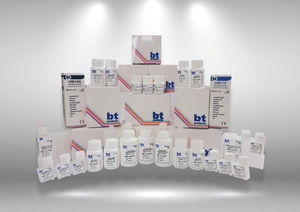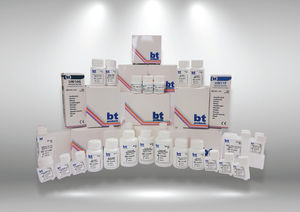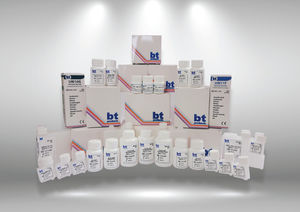
- Laboratory
- Laboratory medicine
- Solution reagent
- BILIMSEL TIBBI ÜRÜNLER
AST reagent kit GOT-11 seriessolutionfor clinical chemistrylactate dehydrogenase
Add to favorites
Compare this product
Characteristics
- Type
- solution
- Applications
- for clinical chemistry
- Tested parameter
- lactate dehydrogenase, NAD, AST
- Storage temperature
Max.: 25 °C
(77 °F)Min.: 2 °C
(36 °F)
Description
For the quantitative determination of Aspartate Aminotransferase (AST) in human serum.
METHODOLOGY
Karmen developed a kinetic assay procedure in 1955 which was based upon the use of malate dehydrogenase and NADH. Optimized procedures were presented by Henry in 1960 and Amador and Wacker in 1962. These modifications increased accuracy and lowered the effect of interfering substances. The IFCC published a recommended method that included P-5-P in 1978. The present method is based on IFCC recommendations but does not contain P-5-P since most specimens contain adequate amounts of this cofactor for full recovery of AST activity.
Principle
Aspartate aminotransferase (AST) catalyzes the transfer of the amino group from Laspartate to α-Ketoglutarate to yield oxalacetate and L-glutamate. The oxalacetate undergoes reduction with simultaneous oxidation of NADH to NAD in the malate dehydrogenase (MDH) catalyzed indicator reaction. The resulting rate of decrease in absorbance at 340nm is directly proportional to the AST activity. Lactate dehydrogenase (LDH) is added to prevent interference from endogenous pyruvate which is normally present in serum.
REAGENT PREPARATION
Prepare working reagent by mixing 4parts of R1 reagent with 1 part R2 reagent.(e.g. 200 µL R1 with 50 µL R2 reagent.)
REAGENT DETERIORATION
Do not use reagent if:
1. The initial absorbance at 340nm is below 1,0.
2. The reagent fails to meet stated parameters of performance.
MATERIALS REQUIRED BUT NOT PROVIDED
1. Accurate pipetting devices.
2. Test tubes/rack.
3. Timer.
4. Spectrophotometer able to read at 340 nm. (UV)
5. Heating bath/block (37°C).
Catalogs
No catalogs are available for this product.
See all of BILIMSEL TIBBI ÜRÜNLER‘s catalogsOther BILIMSEL TIBBI ÜRÜNLER products
Universal Bottled Clinical Chemistry Reagents
Related Searches
- Solution reagent kit
- Protein reagent kit
- Diagnostic reagent kit
- Laboratory reagent kit
- Enzyme reagent kit
- Histology reagent kit
- Dye reagent
- Antibody
- Buffer solution reagent kit
- Clinical chemistry reagent
- Quality control reagent kit
- Clinical chemistry analyzer
- Clinical reagent kit
- Virus reagent kit
- Automatic clinical chemistry analyzer
- Test strip
- Benchtop clinical chemistry analyzer
- Tissue reagent kit
- Electrolyte reagent kit
- Colorimetric reagent kit
*Prices are pre-tax. They exclude delivery charges and customs duties and do not include additional charges for installation or activation options. Prices are indicative only and may vary by country, with changes to the cost of raw materials and exchange rates.













































